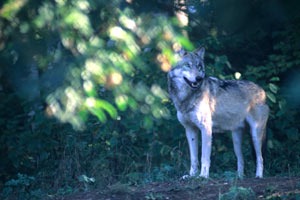Outstanding Tours, Exceptional Habitats and Fascinating Ecology-Themed Attractions
The Mississippi River flows through some of America’s most significant natural areas. The history of the land and people of the region reflects the greater story of the nation’s relationship to the natural environment. You will encounter protected nature areas where the land looks untouched by time. And because the Mississippi River Valley has been continuously occupied longer than any other region of North America, you will also learn about the effects that people
have had on the environment.
Minnesota
In addition to being the source of the Mississippi River, Minnesota is famous for its wilderness areas. Our first stop will be in the far northeast corner of the state, in an area known as the Iron Range, not far from the famous Bounder Waters Canoe Area Wilderness.
North American Bear Center
1926 Highway 169
Ely, Minnesota
bear.org
(877) 365-7879
Few things capture the imagination of wildlife enthusiasts more than black bears. The North American Black Bear Center in Ely offers both indoor and outdoor viewing of live black bears in a natural habitat with a pond and waterfalls. It is the home of Minnesota’s largest black bear and one of the best places in the world to view these fascinating mammals. Decades of scientific research replace myth with facts. You’ll learn meanings of black bear vocalizations and body language and have a chance to view award-winning bear documentaries. But most importantly, you’ll view the resident bears as they forage, swim, and interact with each other.
Just a short way down the road, you’ll find the International Wolf Center.
International Wolf Center
1396 Hwy 169
Ely, Minnesota
wolf.org
(218) 365-4695
The International Wolf Center is located in heart of the Superior National Forest, which happens to be home to the largest remaining wolf population in the lower 48 states. At the International Wolf Center, you’ll have the opportunity to encounter the resident pack of wolves as they play, eat, sleep and tussle. Several times daily, a naturalist will introduce Lucas, MacKenzie and Lakota. The International Wolf Center also features an interactive and entertaining 6,000-squarefoot Wolves and Humans exhibit, developed by the Science Museum of Minnesota.
Wisconsin
Wisconsin is an outstanding destination for birders. The mix of farmland, wetlands and intact habitats offers a diversity of food and shelter necessary for supporting a multitude of species. Throughout Wisconsin, you will find protected wetlands, forests and riverways. One such protected place is the Horicon Marsh.
Horicon Marsh Boat Tours
311B Mill St
Horicon, Wisconsin
horiconmarsh.com
(800) 814-4474
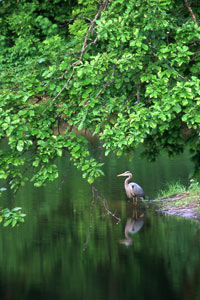
Great Blue Heron, Credit: RJ & LInda Miller
Horicon Marsh’s 32,000 acres of water, woods and prairie are currently home to one of the widest arrays of plants and wildlife in all the Midwest. The best way to experience the marsh is a boat tour. The Horicon Marsh is one of North America’s most important wetland habitats and one of 22 “Wetlands of International Importance” recognized in the U.S. Every corner of the marsh is home to some bird or animal. Pelicans, geese, a huge variety of ducks and shorebirds can be found on the marsh. We’ll take a two hour birding adventure led by an experience boat captain and guide.
The Badger State has a long history of being committed to the protection of wildlife and their habitats. One of the rarest birds on earth, the Whooping Crane, still exists as a species in large part because of the efforts of the International Crane Foundation.
International Crane Foundation
E11376 Shady Lane Rd
Baraboo, Wisconsin
savingcranes.org
(608) 356-9462
The International Crane Foundation is the only place in the world where you can see all 15 species of cranes. We’ll take a guided tour of the facility and the 100-acre restored prairie. And, of course, we’ll see whooping cranes—the rarest crane species in the world.
Iowa
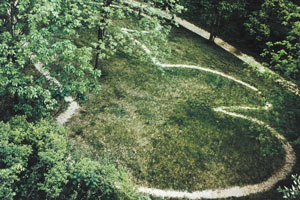
Effigy Mounds
The Mississippi River carved the eastern Iowa border and left beautiful bluffs that offer breath taking views. Effigy Mounds National Monument is a great place to see the sites along the bluffs in Northern Iowa.
Effigy Mounds National Monument
151 Hwy. 76
Harpers Ferry, Iowa
nps.gov/efmo
(563) 873-3491
Effigy Mounds National Monument not only offers river views, but is also the home of special American Indian burial and ceremonial mounds, dating from 500 B.C. to 1300 A.D., located on more than 2,500 acres of forested land.
Illinois
Mississippi River Country offers endless surprises to the observant traveler. Traveling through the agricultural lands of central Illinois, you’ll find the seemingly untouched woodlands of Starved Rock State Park. Glacial melt-water and stream erosion sculpted 18 small canyons into the tree-covered, sandstone bluffs. Each is a spectacular sight. The park also offers some tour opportunities.
Starved Rock Lodge Land and Water Cruise
Rte 178 & 71
Utica, Illinois
starvedrocklodge.com
(800) 868-7625
Take a tour aboard a historical trolley, enjoy lunch and then take a leisurely one hour river cruise on the ‘Belle of the Rock,’ an authentic paddle wheel boat.
As one travels southward in Illinois, the landscape changes drastically. Flat plains are replaced by rolling hills and forests. The Shawnee National Forest stretches for 280,000 acres across southern Illinois, sometimes called the Illinois Ozarks. The most breathtaking portion of the Shawnee National Forest is the Garden of the Gods Recreation Area.
Garden of the Gods Recreation Area – Shawnee National Forest
Off Rd. #17
Karbers Ridge, Illinois
(618) 287-2201
fs.usda.gov
The recreation area covers over 3,300 acres of beautiful old growth forest. The rock formations of the Garden of the Gods is over 320 million years old. The sediment rock in this area is over four miles deep and the fractured bedrock has created peculiar rock formations.
Missouri
At the center of the lower 48 states, you’ll find the Ozarks, a region of low mountains and idyllic valleys. In a region of farmland and sprawling river valleys, the Ozarks are an extraordinary sight.
One of the most striking features of Missouri’s Ozark region is the abundance of picturesque riverways. Paddling is the best way to experience southern Missouri’s rivers. The most popular of the many rivers are the Current and Jack’s Fork, designated as Ozark National Scenic Riverways. The Jacks Fork River is 44.6 miles long. The first 25 miles from the Prongs to Bay Creek is deep valley, nearly a canyon.
There are a number of outfitters offering guide services, canoe and kayak rentals and shuttle services—here are just a few.
Running River Canoe Rental
Salem, Missouri 65560
runningrivercanoe.com
(800) 226-6394Akers Ferry Canoe Rental
Current River
Salem, MO
(800) 333-5628Jacks Fork River
Eminence, MO
(800) 522-5736Jacks Fork Canoe Rental
Hwy 106
Eminence, Missouri 65466
(800) JACKS-FORK
The Mississippi River corridor is a major flyway for North American birds. Each season brings new species to the region’s forests, fields and wetlands. This abundance of habitat, coupled with numerous protected nature areas for wildlife viewing, make it an outstanding birdwatching destination.
Our next stop will be on dry land and focus on rare creatures of the canine variety.
Endagered Wolf Center
Tyson Valley Road
Eureka, Missouri
endangeredwolfcenter.org
(636) 938-5900
The Wild Canid Center, popularly known as the Wolf Sanctuary, was founded in 1971 by noted naturalist Dr. Marlin Perkins. The facility is the premier wolf conservation, education, reproduction and research center. The center is located on 63 isolated wooded acres within Washington University’s Tyson Research Center, approximately 20 miles southwest of St. Louis. It is the first facility in the United States to have a captive breeding program for both red and Mexican gray wolves. We’ll tour the facility and learn about its research and mission.
Kentucky
The unique geology of Kentucky makes it one of the best places in the world for caves to develop. Natural underground labyrinths abound, including the largest known cave system on earth.
Mammoth Cave National Park
1 Mammoth Cave Pkwy
Mammoth Cave, Kentucky
(270) 758-2180
nps.gov/maca
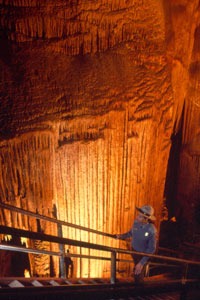
Mammoth Cave National Park
Mammoth Cave is one of the oldest tourist attractions in North America. Tours of Mammoth Cave have been offered since 1816. Mammoth Cave National Park preserves the cave system and a part of the Green River valley and hill country of southcentral Kentucky. More than 376 miles of Mammoth Cave have already been explored. A wide range of tours are available, each led by an experienced guide.
From Mammoth Cave, we’ll travel east to an area known as the Land Between the Lakes, a natural area known for its herds of elk.
Saddle Up Elk Tours
250 Hale Cemetery Road
Beech Road off KY Hwy 80
Mallie, Kentucky
trailsrus.com/saddleuptours
(606) 642-3656
Saddle Up Elk Tours offers 2 ½ hour guided trail rides through elk country to view elk and other wildlife by horseback. Ride through wooded areas and streams. Enjoy panoramic mountaintop views, spring wildflowers and beautiful fall foliage. In the fall, hear the bull elk bugle and watch them form and protect their harems. Morning and evening tours are available.
Tennessee
At the westernmost end of Tennessee, lakes, rivers and wetlands are a dominant feature. One of the most important wetlands in the U.S. is Reelfoot Lake, a complex of open water, flooded timber forests and swamps that offers migrating birds a crucial stopover and nesting habitat.
Reelfoot Scenic Boat Cruises
Visitor Center/Ellington Assembly Hall
2595 State Route 21E
Tiptonville, Tennessee
reelfoot.com
(731) 253-9652
Since 1961, Reelfoot Scenic Boat Cruises have been piloting visitors on beautiful Reelfoot Lake. You’ll cruise along the islands and through flooded timber and lily pads while state park naturalists offer insight and information about the flora, fauna and ecology of the lake. Reelfoot National Wildlife Refuge was established in 1941 to manage the northern third of Reelfoot Lake as a refuge for migratory birds. Additional lands acquired in Southwestern Kentucky expanded the refuge to it s current 10,428 acres. The proximity of Reelfoot Lake and the refuge to the Mississippi river has always made the area a major stopover and wintering ground for migratory waterfowl and bald eagles. A boat tour enables you to see parts of the lake that otherwise would be completely inaccessible.
Tennessee is a big state with an incredible diversity of natural habitats. In the eastern part of the state, the landscape is dominated by ancient mountains. The most scenic part of this area is the Great Smoky Mountains National Park.
The Great Smoky Mountains National Park, a World Heritage Site, preserves a rich cultural tapestry of Southern Appalachian history. The mountains have had a long human history spanning thousands of years. World-renowned for its diversity of plant and animal life and the beauty of its ancient mountains, this is America’s most visited national park.
Because of its vast size, an ideal way to experience the park is a driving tour.
Cades Cove Heritage Tours
123 Cromwell Dr
Townsend, Tennessee
(865) 448-8838
cadescoveheritagetours.org
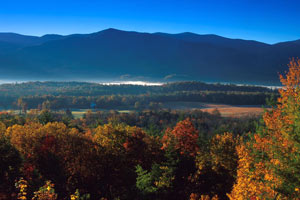
Cades Cove
Learn all about the history, personal stories, and natural resources that make Cades Cove and the Smoky Mountains so unique. Biological diversity is the hallmark of Great Smoky Mountains National Park, and no other area of equal size in a temperate climate can match the park’s amazing diversity of plants, animals and invertebrates. Among the birds viewed in the park are Henslow’s Sparrow, Olive-sided Flycatcher, Cerulean Warbler, Red Crossbill, Black-capped Chickadee, Yellow-bellied Sapsucker, Golden-winged Warbler and the endangered Redcockaded Woodpecker.
Arkansas
“The Natural State” truly lives up to its name. From mountain views and caves to storybook glades and raging rivers, Arkansas is truly blessed with natural beauty. There’s so much to see that the best way to take it in is through a driving tour. If you’ve never seen the Boston Mountains section of the Ozarks, you’re in for a real surprise.
Boston Mountains Scenic Loop – 80 mile loop
arkansas.com/mountainburg/motoring/boston-mountains-scenic-loop
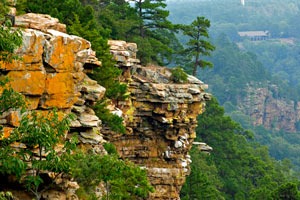 Running between Alma and Fayetteville in northwest Arkansas, this scenic loop provides one breathtaking view after another. Following a former stagecoach route, U.S. 71 rises and falls, twists and turns through the mountain landscape, allowing travelers to intimately experience the rugged terrain. Along the way are small mountain towns, roadside farms, antique and other shops, and travel courts. Not far to the west, I-540 crosses mountains streams, valleys and ridges. Both routes offer impressive mountain vistas.
Running between Alma and Fayetteville in northwest Arkansas, this scenic loop provides one breathtaking view after another. Following a former stagecoach route, U.S. 71 rises and falls, twists and turns through the mountain landscape, allowing travelers to intimately experience the rugged terrain. Along the way are small mountain towns, roadside farms, antique and other shops, and travel courts. Not far to the west, I-540 crosses mountains streams, valleys and ridges. Both routes offer impressive mountain vistas.
The mountainous landscape and numerous geological features that you see are a reflection the mineral abundance that Arkansas possesses. At our next stop, we’ll learn about the mining, oil and mineral industries in Arkansas.
Arkansas Museum of Natural Resources
3853 Smackover Highway
Smackover, Arkansas
arkansasstateparks.com/museumofnaturalresources
(870) 725-2877
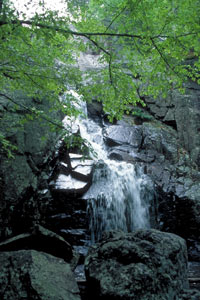 In the 1920s, nationwide attention focused on south Arkansas when the Smackover field was ranked first among the nation’s oil fields. For five months in 1925, the 40-square-mile Smackover field was the focal point of one of the wildest mineral booms in North America. Knowledgeable museum guides will give you insight into this exciting but little-known era, as well as Arkansas’s other mineral-related industries, including modern-day petroleum drilling and bromine extraction.
In the 1920s, nationwide attention focused on south Arkansas when the Smackover field was ranked first among the nation’s oil fields. For five months in 1925, the 40-square-mile Smackover field was the focal point of one of the wildest mineral booms in North America. Knowledgeable museum guides will give you insight into this exciting but little-known era, as well as Arkansas’s other mineral-related industries, including modern-day petroleum drilling and bromine extraction.
Mississippi
Our next stop is the State of Mississippi. Like Louisiana, Mississippi offers a wealth of swamps, bayous and wetlands. Our first Mississippi excursion will be a tour of the Pascagoula River. This maze of swamps and wetlands teems with wildlife. You’ll cruise along cypress forests beneath elegant Spanish moss. See alligators, pelicans and woodpeckers and other unique creatures that inhabit the Pascagoula. Several area outfitters offer both boat tours and guided kayak tours. Here are just two:
Eco-Tours of South Mississippi
Gautier, Mississippi
ecotoursofsouthmississippi.com
(228) 297-TOUR (8687)McCoy’s River and Marsh Tours
Pascagoula River Audubon Center
7001 Frank Griffen Road
Moss Point, Mississippi
mccoyrivertours.com
(228) 588-0356
The fertile river estuaries and shallow coastal waters make the Gulf Coast an important commercial fishing region. The economies of entire communities along Mississippi’s Gulf Coast depend on the rich waters for their survival.
Our next stop in Mississippi will be Biloxi, located on the Gulf of Mexico in some of the richest fishing waters in North America.
The Biloxi Shrimping Tour
Small Craft Harbor
Biloxi, Mississippi
(800) 289-7908
biloxishrimpingtrip.com
For more than 50 years, visitors to Biloxi have boarded the Sailfish for the Biloxi Shrimping Tour. This 70-minute educational cruise is a fun way to experience the pride and heritage of Biloxi’s commercial fishing culture. Dolphins are frequently seen on cruises. A dockside shrimp boil is also available, as are special sunset cruises.
Louisiana
We begin our 10-state Mississippi River Country eco-tour in Louisiana. Located at the southernmost end of the Mississippi River, Louisiana offers outstanding swamps, winding river and vast coastal wetlands. This environment supports diverse fisheries and numerous opportunities for travelers to see and experience one of America’s most unique ecological landscapes.
Our eco tour begins in New Orleans. It may come as a surprise that our eco-tour concludes in Louisiana’s largest city. But New Orleans is literally surrounded by water and wetlands. We’ll explore the balance between nature and civilization on a boat tour from New Orlean’s own Pearl River Eco-Tours.
Pearl River Eco-Tours
535 S Clark St
New Orleans, Louisiana
(504) 581-3395
pearlriverecotours.com
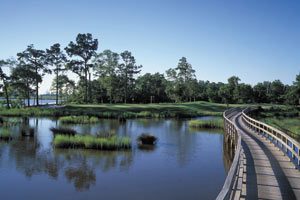
Audobon Golf Trail
Experienced guides will lead a boat tour through the majestic cypress trees and winding bayous of south Louisiana’s Honey Island Swamp. It’s a true wilderness area, loaded with birds, fish, reptiles and a number of rare plants. New Orleans is also home to the Audubon Nature Institute, home of several attractions.
Audubon Zoo
6500 Magazine Street
New Orleans, Louisiana
(866) ITS-AZOO (487-2966)
The Audubon Zoo is one of the nation’s top-ranked zoos, offering an exotic mix of animals from around the globe, engaging natural habitats, lush gardens and resting spots, the mystical Louisiana swamp and ‘hands-on’ animal encounters.
Audubon Aquarium of the Americas and the Entergy IMAX® Theatre
1 Canal Street
New Orleans, Louisiana
(504) 581-4629 OR 1-800-774-7394
At the Audubon Aquarium of the America’s, you’ll walk beneath the vivid Caribbean Reef, marvel at the lush beauty of the Amazon Rainforest and journey the Mississippi River.
Audubon Insectarium
US Custom House
423 Canal Street
New Orleans, Louisiana
(504) 581-4629 OR 1-800-774-7394
The Audubon Insectarium, located in the historic U.S. Custom House on Canal Street in downtown New Orleans, where you’ll discover global insect customs, sample exotic insect cuisine, learn about the history of termites and the latest technologies used in pest control management.
This concludes the 10-state tour. You’ve seen just a few of the outstanding attractions available in Mississippi River Country. For more information on lodging, dining and all that this exciting region has to offer nature enthusiasts, explore the website!







